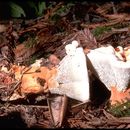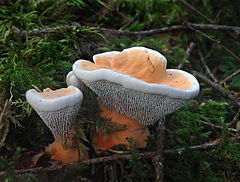pt-BR
nomes no trilho de navegação


Hydnellum aurantiacum is an inedible fungus, commonly known as the orange spine or orange Hydnellum for its reddish orange or rusty red colored fruit bodies. Like other tooth fungi, it bears a layer of spines rather than gills on the underside of the cap. Due to substantial declines in sightings, this species is listed as critically endangered in the United Kingdom.[2][3]
Hydnellum aurantiacum was first described by the German naturalist August Batsch in 1789, with the name Hydnum suberosum var. aurantiacum.[4] It was given its current scientific name by Petter Karsten, who transferred it to Hydnellum in 1879.[5] Hydnellum aurantiacum has acquired several synonyms in its taxonomic history, including Hydnum stohlii, published by Gottlob Ludwig Rabenhorst in 1873, and Hydnellum complectipes, published by Hall in 1972.[6] Additional synonyms resulting from generic transfers include Hydnum aurantiacum (Johannes Baptista von Albertini and Lewis David de Schweinitz, 1825); Calodon aurantiacus (Karsten, 1881); and Phaeodon aurantiacus (Joseph Schröter, 1888).[1]
The specific epithet aurantiacum is derived from the Latin for "orange". Common names for the fungus include "orange spine",[7] "orange corky spine fungus",[8] and the British Mycological Society approved English name "orange Hydnellum".[9]
Fruitbodies are shallowly funnel-shaped (infundibuliform), and up to 15 cm in diameter. The upper surface is orange or orange-brown in the centre, with a lighter margin. It may be velvety or tomentose when young, but will become wrinkled or lumpy in age. The flesh is tough and woody, pale to dark orange-brown in color, without any distinctive odor but a bitter or mealy taste.[10] The teeth are short (up to 5 mm long), white, but the tips gradually turn brown with age. The stipe is up to 4 cm long and 0.5–2 cm thick, orange to dark brown in color, with a velvety surface.[11] The spore print is brown. This species is inedible[12] due to the toughness of the flesh and its poor taste.[13]
Basidia (the spore-bearing cells) are between 35 and 46 by 8–11 µm, club-shaped (clavate), without clamp connections, and four-spored. The sterigmata (extensions of the basidia bearing spores) may be up to 6 µm long. Basidiospores are roughly spherical in shape, with rough warty outgrowths (tubercles), nonamyloid, and have dimensions of 5.5–8 by 5.5–6.5 µm.[14]
The species resembles the polypore Phaeolus schweinitzii when viewed from the top of the cap surface, but it has teeth instead of pores on the hymenium. Closely related and morphologically similar species in the genus Hydnellum include H. auratile (has more uniformly coloured flesh), H. caeruleum (may look similar in age),[15] H. congenum (has thin flesh in the cap), H. ferrugipes, H. earlianum (has a smoother cap, and spines have sulfur-yellow tips, not white).[7][16]
This species is typically found growing solitary or in clusters on the ground in conifer and mixed woods. Rarely, fruit bodies may have their stipes fused together.[6] Hydnellum aurantiacum has been reported from Australia,[17] Europe, North America,[18] and Asia, including China[19] India,[20] and Korea.[21] It is one of the most frequently encountered Thelephorales species found in the Sverdlovsk region of Russia.[22]

The pigment responsible for the characteristic orange color of H. aurantiacum has been identified as the p-terphenyl compound named aurantiacin.[23] This dark red pigment, a derivative of the compound atromentin, has subsequently been identified in other species of Hydnellum.[24] The compounds dihydroaurantiacin dibenzoate and thelephoric acid have also been reported.[25]
Hydnellum aurantiacum is used in mushroom dyeing, in which it produces grayish to greenish-gray colors depending on the mordant used.[26]
Hydnellum aurantiacum is an inedible fungus, commonly known as the orange spine or orange Hydnellum for its reddish orange or rusty red colored fruit bodies. Like other tooth fungi, it bears a layer of spines rather than gills on the underside of the cap. Due to substantial declines in sightings, this species is listed as critically endangered in the United Kingdom.
Oranssiorakas (Hydnellum aurantiacum) on nahkaorakkaisiin kuluva yleinen metsäsieni. Sen itiöemä on väriltään oranssinruskea, siinä on usein myös valkeita värejä, ja lakin alapinnalla selkeästi havaittava piikistö. Jalka on kovahko, halkaistuna vyöhykkeinen, mutta valkeat ja siniset värit puuttuvat. Sieni on sammalikoilla ja mäntykankailla yleisehkö. Haju on tunnettavissa ja sitä on kuvattu jauhomaiseksi, erityistä makua ei juuri ole. Ruokasieneksi laji on liian kova ja sitkeä, mutta sienivärjäykseen se kelpaa. Siitä on eri puretuksilla saatu lankaan vihertäviä värisävyjä.[2][3]
Oranssiorakas (Hydnellum aurantiacum) on nahkaorakkaisiin kuluva yleinen metsäsieni. Sen itiöemä on väriltään oranssinruskea, siinä on usein myös valkeita värejä, ja lakin alapinnalla selkeästi havaittava piikistö. Jalka on kovahko, halkaistuna vyöhykkeinen, mutta valkeat ja siniset värit puuttuvat. Sieni on sammalikoilla ja mäntykankailla yleisehkö. Haju on tunnettavissa ja sitä on kuvattu jauhomaiseksi, erityistä makua ei juuri ole. Ruokasieneksi laji on liian kova ja sitkeä, mutta sienivärjäykseen se kelpaa. Siitä on eri puretuksilla saatu lankaan vihertäviä värisävyjä.
Cost artìcol a l'é mach në sbòss. Da finì.
A chërs ant ij bòsch ëd conìfere, ma ëdcò ëd latifeuje.
![]() A venta mai mangé un bolè trovà se un a l'é nen un bon conossidor dij bolè!
A venta mai mangé un bolè trovà se un a l'é nen un bon conossidor dij bolè!
As peul nen mangesse.
Cost artìcol a l'é mach në sbòss. Da finì.
AmbientA chërs ant ij bòsch ëd conìfere, ma ëdcò ëd latifeuje.
Comestibilità![]() A venta mai mangé un bolè trovà se un a l'é nen un bon conossidor dij bolè!
A venta mai mangé un bolè trovà se un a l'é nen un bon conossidor dij bolè!
As peul nen mangesse.
Kolczakówka pomarańczowa (Hydnellum aurantiacum (Batsch: Fr.) P. Karst) – gatunek grzybów należący do rodziny kolcownicowatych (Bankeraceae)[1].
Pozycja w klasyfikacji według Index Fungorum: Hydnellum, Bankeraceae, Thelephorales, Incertae sedis, Agaricomycetes, Agaricomycotina, Basidiomycota, Fungi[1].
Po raz pierwszy takson ten zdiagnozował w 1789 r. Batsch nadając mu nazwę Hydnum suberosum var. aurantiacum. Obecną, uznaną przez Index Fungorum nazwę nadał mu w 1879 r. P. Karst., przenosząc go do rodzaju Hydnellum[1]. Niektóre synonimy[2]:
Nazwę polską podali Barbara Gumińska i Władysław Wojewoda w 1968 r. W polskim piśmiennictwie mykologicznym gatunek ten opisywany był też jako kolczak pomarańczowy[3].
5-10 cm średnicy, początkowo wypukły, później wklęsły aż do lejkowatego. Nieregularny, na powierzchni pokryty wyrostkami, na brzegach promieniście pomarszczony. Koloru pomarańczowego, pomarańczowożółtego, pomarańczowobrunatnego, na brzegu jaśniejący, białawy, z koncentrycznymi, bladymi strefami. Kolce zbiegające na trzon, początkowo białopomarańczowe, później ciemniejsze, purpurowobrązowe, do 5 mm długie[4].
Długi do 10 cm, gruby od 0,3 do około 2 cm. Barwy żółtawopomarańczowej, pomarańczowobrunatnej do ciemnobrunatnej. Aksamitny lub wełnisty, w końcu kłakowaty[4].
Pomarańczowordzawy, w kapeluszu bardziej pomarańczowożółtawy, strefowany, korkowaty. Zapach mączny, czasem także z dodatkiem składnika gorzkich migdałów[4].
Brązowawe, ze spłaszczonymi guzkami, o średnicy 4,5-6,5 × 4-5,5 µm[4].
W Polsce podlega ścisłej ochronie gatunkowej[5]. Znajduje się na Czerwonej liście roślin i grzybów Polski. Ma status E – gatunek wymierający[6]. Znajduje się na listach gatunków zagrożonych także w Danii. Niemczech, Anglii, Holandii[3].
Rośnie od czerwca do października, pojedynczo lub w grupach w lasach iglastych i mieszanych, na glebach zawierających wapń, częściej na obszarach górskich; rzadka[4].
Kolczakówkę pomarańczową można pomylić z kolczakówką strefowaną (Hydnellum concrescens), która ma owocniki ciemniejsze, bez pomarańczowej barwy, z ciemnym, czarniawym strefowaniem. Porównaj też z niejadalną kolczakówka niebieskawą (Hydnellum caeruleum), której miąższ ma oprócz pomarańczowych także strefy niebieskawe[4].

Kolczakówka pomarańczowa (Hydnellum aurantiacum (Batsch: Fr.) P. Karst) – gatunek grzybów należący do rodziny kolcownicowatych (Bankeraceae).